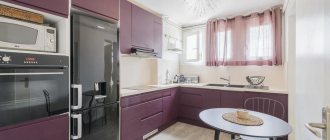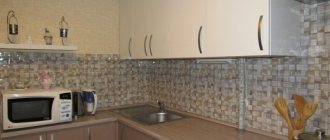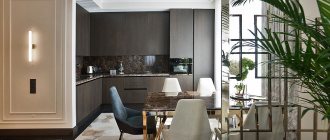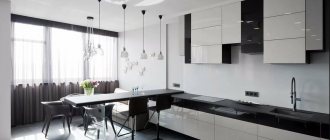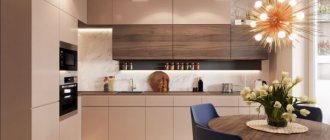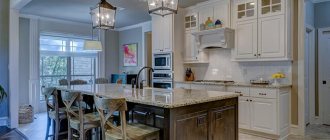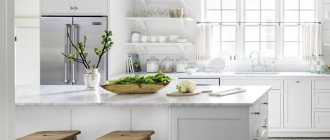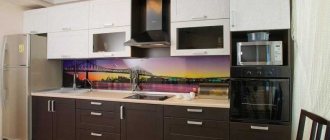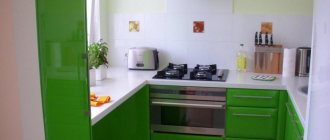The kitchen is one of the main rooms in modern apartments. When making renovations, you want to give it originality, sophistication and comfort. The lilac color used in the design of this space will cope with this task. We will tell you in the article what nuances should be taken into account when arranging a lilac kitchen, what elements of the space should be decorated in this color scheme, as well as the compatibility of lilac with other colors.
Features of lilac color in kitchen design
Lilac can be used in the design of almost any room, the only question is in what quantity and in combination with what colors. He has his own mission in kitchen design. Here are some facts about the use of this color in the interior:
- One of the most “inedible” colors in design. If you tend to overeat, this is an additional way to control your appetite.
- It has many shades: from pale to rich, from cold to warm. The choice of tone will be influenced by the style of the interior, the location of the windows and the degree of natural light in the kitchen space.
- A large amount of this color in a kitchen design will “heavien” the interior, so it is best to use it as accents or dilute it with neutral ones - gray, white, sand, etc.
- The smaller the kitchen, the lighter the shade should be.
- This is the ideal color for a Provence style kitchen design.
- Dusty shades look very beautiful in combination with rough, textured surfaces, for example, with stone, concrete, wood with a pronounced texture and wicker furniture.
Decor ideas
Lilac-colored details will appeal to those who want to brighten up the kitchen without resorting to large-scale measures. Lilac curtains look neat and aesthetically pleasing. Windows in a classic style are complemented by light, plain, white tulle. Roller blinds or Roman blinds are suitable for modern interiors. They take up minimal space, make the space airier and lighter, an excellent option for small kitchens.
The color of lilac is suitable for decorating drawings and paintings on walls, for ceramic figurines, and tableware. It goes well with grassy green; lilac plant pots and vases look unusual and support the style of the kitchen interior. Horizontal surfaces are decorated with violets or lavender.
Variety of shades
A positive perception of lilac in the interior is formed primarily due to the successful choice of shade.
This may also be interesting to read:
- Turquoise color in the kitchen interior - 120 design options in photos
- 117 Best Examples of Dark Kitchen Designs
Pale or bright?
Lilac can be used as a background, accent or as a complementary color. In the first case, it is recommended to select pale, pastel shades, and in the second, use brighter colors.
As the main, dominant background
Accent
It can also act as an additional color in the company of white, gray, black, pistachio, yellow and other colors. In this case, it is important to guess not only with the shade, but also with the proportions.
The color scheme of this kitchen is based on three colors - white, lilac, blue. Bronze/gold/orange is used as accents in the design of fittings, lamps, and kitchen accessories.
Warm or cold?
Lilac is a mixture of blue and red. To achieve complex, interesting shades, add white or light gray, which gives a beautiful dusty effect. Unlike purple, it has more blue undertones, but you can play with proportions, getting a variety of shades from warm to cold.
If the kitchen windows face north, then you can compensate for the lack of sun with the help of a warm shade.
If the windows face south and the bright sun comes into the room most of the day, then cool tones will look more harmonious, adding coolness and freshness.
White and purple design
The traditional combination, which has not gone out of fashion for more than ten years, is suitable for both small and spacious rooms.
A fashionable option is a modern U-shaped kitchen with glossy purple facades and white countertops. This set is convenient due to its wide working surface. We recommend purchasing built-in household appliances to create a holistic composition.
An apron with a print will be a good accent. Find drawings for him that look organic in purple tones. Ideal, in our opinion, flowers. Lavender, violets, irises - the choice is quite wide. The main thing is that the image is of high quality and clear, otherwise the result will not be very attractive.
However, you can also use berries if you plan to add bright colors. We recommend making a wide, long apron over the entire work surface.
A beautiful white and purple kitchen will turn out if you decorate it in muted lilac tones. This is a more classic design option, so choose furniture and appliances that are appropriate: without too complex shapes or matte texture. As a decoration, we recommend purchasing a ball chandelier with an elegantly woven lampshade.
What does it go with?
Lilac is a very difficult color to work with. It has a strong emotional impact. If you overdo it, the kitchen will resemble the interior of an elderly Barbie. But in the hands of a person who has excellent taste, it is a powerful tool for creating a non-standard, creative, inspiring space.
With white
The most win-win and successful combination is with white. Shades of white can always be added to the palette with lilac and other bright tones to unload and refresh the interior.
White adds air to the room, allows you to play with the proportions of colors in the interior, helping to find balance.
With gray
The combination with gray will add high cost, severity and elegance to the interior, since gray slightly mutes lilac and its infantile character, thus revealing its best qualities.
In the high-tech style, gray is reflected in the design of metal and chrome surfaces, which adds a technological atmosphere to the interior.
Kitchen color therapy
The calm and subdued interior in lilac tones is simply shown to desperate people who have lost faith in the future and self-esteem. It is also a good idea to have a room in the house with lilac decoration for those families where there are patients with epilepsy, multiple sclerosis or those who have suffered severe concussions. For them, it will also become a panacea, but it is better to decorate a bedroom or living room in such a palette.
But housewives who are constantly struggling with extra pounds really need a lilac kitchen in which they would spend as much time as possible. Such an interior will really help to restore a slim figure, because the lilac color can suppress appetite. So if you still had any hesitations regarding the choice of kitchen decor color, then feel free to throw them aside. Have no doubt, this color scheme is just a godsend for you.
lilac kitchen is an excellent solution for people who are overweight
The situation is more complicated with the decoration of houses where alcoholics or mentally ill people live. There is absolutely no place for the violet spectrum in general and the lilac color in particular. They will only awaken feelings of anxiety and plunge the unfortunate into long-term and deep depression.
What style should you use for a lilac kitchen?
In certain styles, lilac will reveal its best qualities. Let's take a closer look at how this color can be used in traditional and modern interiors.
Provence
The most ideal scenario is to use it in French country style. Here he will most harmoniously reveal his serene mood. It is better to use dusty, dirty, muted tones. In combination with rough and aged wood in the design of ceiling beams or furniture, stone in the design of the floor and cold light plaster on the walls, lilac will never give a cloying and irritating effect.
Modern classic
Light lilac can be used in the design of kitchen furniture, in the textile design of a kitchen in the neoclassical style. Brighter tones closer to purple will add luxury and richness to the setting. It is better to dilute such an interior with calm milky, beige, white shades so that lilac of varying degrees of brightness fits harmoniously into the overall atmosphere without sharp transitions and contrasts.
Shabby chic
In the shabby chic style, warmer, lilac tones will prevail, which, unlike Provence, will create a slightly infantile, marshmallow mood. In addition to it, the interior may contain a lot of pink, milky, white, and soft blue.
Country
Against the background of the natural palette of a country interior, lilac will harmoniously serve as accents, and in a muted, very pale form, it will also act as a background.
Cornflower blue, violet, and not too bright tones will add coziness and bring you even closer to nature, evoking associations with fragrant wildflowers.
Scandinavian
In the Scandinavian style, it is better to use lilac spotwise, as small accents, for example, in the form of floor paths, napkins for cutlery, and pillows on chairs.
Modern kitchen
Shades of lilac fit harmoniously into modern interiors - loft, minimalism, hi-tech.
In minimalism, it is better to use cold, muted tones, with a mixture of white and gray.
Bright lilac with a slight vintage mood can be used in the decor of a loft kitchen, for example, in such oversized, small details as upholstery, an apron or a poster on the wall. You can use a gray-lilac, dirty shade in greater quantities, which will emphasize the brutality of the loft.
In the high-tech style, lilac is diluted with white chrome, gray, and metallic shades. Gloss, glass and metal work best alongside neutral and muted shades.
Green
Creating such a duet in the interior requires special care. After all, despite the fact that the combination is one that can be found in nature, it requires a competent choice of shades. For example, too saturated or dark green in large quantities can overload the interior and make it too gloomy.
In classic kitchens, the lilac-green duet can be found relatively often, but it is necessarily complemented by neutral light colors - white, beige.
Moderate delicate shades are characteristic of Provence. More intense ones are for modernity.
Photo from source: mebel-sirius.ru
Lighting Features
Lilac can change its undertone under certain lighting. Due to the lack of artificial lighting, a lilac kitchen may seem gloomy and uncomfortable. Therefore, it is important not only to take care of the moderate brightness of the main light, but also to evenly distribute sources of artificial lighting throughout the room - to illuminate the work area, to provide separate lighting for the dining area.
